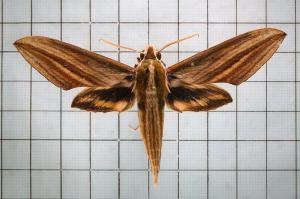Dr. Weeks’ Comment: We humans consider ourselves to be the pinnacle of creation but most of us can’t produce what these moths do in order to jam the radar of predator bats: produce sonic pulses from our…. genitals!
Hawkmoths Use Ultrasound to Combat Bats
July 4, 2013 ”” For years, pilots flying into combat have jammed enemy radar to get the drop on their opponents. It turns out that moths can do it, too.A new study co-authored by a University of Florida researcher shows hawkmoths use sonic pulses from their genitals to respond to bats producing the high-frequency sounds, possibly as a self-defense mechanism to jam the echolocation ability of their predators.
Echolocation research may be used to better understand or improve ultrasound as a vital tool in medicine, used for observing prenatal development, measuring blood flow and diagnosing tumors, among other things. The study appears online today in the journal Biology Letters.
Study co-author Akito Kawahara, assistant curator of Lepidoptera at the Florida Museum of Natural History on the UF campus, said ultrasound has only been demonstrated in one other moth group.
“This is just the first step toward understanding a really interesting system,” Kawahara said. “Echolocation research has been focused on porpoises, whales and dolphins. We know some insects produce the sounds, but this discovery in an unrelated animal making ultrasound, potentially to jam the echolocation of bats, is exciting.”
Hawkmoths are major pollinators and some are agricultural pests. Researchers use the insects as model organisms for genetic research due to their large size.
Previous research shows tiger moths use ultrasound as a defense mechanism. While they produce the sound using tymbals, a vibrating membrane located on the thorax, hawkmoths use a system located in the genitals. Scientists found at least three hawkmoth species produce ultrasonic sound, including females. Researchers believe hawkmoths may produce the sound as a physical defense, to warn others or to jam the bats’ echolocation, which confuses the predators so they may not identify an object or interpret where it is located, Kawahara said.
The study was conducted in Malaysia, which has the highest diversity of hawkmoths worldwide, and funded by a National Science Foundation grant of about $500,000. Kawahara also conducted research in the jungles of Borneo and the lower Amazon.
“So much work has been focused on animals that are active during the day, but there are a lot of really interesting things happening at night, and we just don’t know a lot about what is actually going on — because we can’t hear or see it,” Kawahara said. “The fascinating part is that there are a lot of new discoveries to be made. It’s a totally unknown, unexplored system.”
Kawahara’s team from the Florida Museum’s McGuire Center for Lepidoptera and Biodiversity used high-energy lamps to capture the hawkmoths in the jungle. Study co-author Jesse Barber’s team from Boise State University played pre-recorded bat sounds to the insects, and all researchers studied their behavior. With the insects tethered inside an enclosed sound rig containing an ultrasonic microphone and speaker connected to two laptop computers, researchers recorded the sounds the hawkmoths made in response to being touched and hearing the echolocation sounds. The responsive species include Cechenena lineosa, Theretra boisduvalii and Theretra nessus.
“As a museum, we are creating a library of life,” Kawahara said. “Museum specimens are usually preserved immediately, but we are trying to understand the behavior of these organisms so that we have a record of their behavior along with the specimen and DNA. This is why there are so many interesting things we’re starting to discover.”
Hawkmoths are among the fastest and most proficient flying insects, and more than 1,400 species occur worldwide. Their long proboscis, or mouthpart, makes them important pollinators, since many plants may only be pollinated by hawkmoths.
Study collaborators plan to continue researching the use of ultrasound in hawkmoths, focusing on the evolution of the insects to see if other hawkmoth species use this system, Kawahara said.
“We think hawkmoths are a primary food source for bats because none appear to be chemically defended, which is why they have evolved anti-bat ultrasound strategies,” Kawahara said. “Hawkmoths have evolved different ways of avoiding bats — I can’t even explain how amazing the system is, it is just fascinating.”
Journal Reference:
- J. R. Barber, A. Y. Kawahara. Hawkmoths produce anti-bat ultrasound. Biology Letters, 2013; 9 (4): 20130161 DOI:10.1098/rsbl.2013.0161


